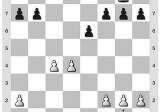.
To Dr. D's general delight, other posters have gotten interested in Sports Illustrated's article on pattern recognition in chess and sports. It should be required reading for sabermetricians, required reading in the sense that the periodic table is required reading for a young med school student wishing to become a doctor.
Let's take a simple and charming example. The following pawn structure is referred to as a "hanging pawn" position. Imagine this structure with a whole bunch of pieces still on the board:

If BLACK does nothing, the pawns will confine his pieces to the back couple of ranks. White's pieces will move forward and centralize. He'll put a Knight on e5 and attack Kingside, or he'll mass on the b-file with rooks and pressurize the b-pawn. White will "sit on him, until he cracks him with a tactic" (like a fork or pin).
So White's goal is to (1) ensure that the c4 and d4 pawns are well protected, and then (2) to mass forward for an attack on either side.
If WHITE does nothing, then Black will pressurize the c4-pawn until White plays the pawn up, from c4 to c5 to protect it. Then the pawns will become ossified targets -- Black will block them with Knights on the light squares c6 and d5. His Bishop goes to f6, defending the Kingside and hitting the d4-pawn ... all very easy.
So Black's goal is to (1) exchange pieces to defuse general attack situations, then (2) to force the c4-pawn forward, then (3) to blockade the pawns, (4) attack them and (5) finally win material, using a variety of finish strategies.
If that sounds like Black's job is the harder one, that's because it is. White wins more often than he loses. But! In a club tournament, the winner is whichever player knows the above principles :- )
.
VARIATIONS on TEMPLATES and PATTERNS
Okay, if you know the above, then strategically you're playing at the 90th percentile in your club tournament. Let's bring you to the 98th percentile in two minutes.
Consider a variation on this position. Suppose for a second that you have a similar position -- but Black's b7 pawn is missing, and so is White's a2-pawn. How does that MODIFY our basic understanding?
You guessed it! Now White's pawn push, c4-c5, is no longer strategically losing. Now it is strategically winning, because the c5-pawn is "passed" and a deadly threat to Queen on the 8th rank.
Chess experts -- local stars -- are very good with the stock templates. Chess grandmasters -- world-class stars -- operate in the realm of variations off the stock templates.
This is comparable to saying that a baseball blogger might win his local tournament if he could correctly put Michael Pineda into a Curt Schilling template -- and realize that a 3rd pitch is not germane to the position. Or you could correctly forecast Erasmo Ramirez if it turns out to be true that he is in a Doug Fister / Hisashi Iwakuma template. Or Blake Beavan could be correctly forecasted if it turned out to be true that he was in a PCL template (all PCL pitchers are very good pitchers).
But a baseball super-grandmaster ... let's say Pat Gillick, or perhaps you want to consider Jack Zduriencik here ... recognizes not only Pineda's classification in the Schilling template, but also sees a difference between the two pitchers: Pineda's elbow is carried rather higher...
That is totally different from starting out saying "Pineda is not Schilling." That would be like a chessplayer taking our modified position and scoffing "That's not a hanging pawns position." It is! It's the best possible Hanging Pawns position for White.
Dr. D makes no claims that he gets all the patterns right. Nobody does! He claims only that he consistently tries to use this approach to solve baseball problems. But you can see why he believes this is important.
...........
Anyway. Now you guys are "getting it" (aha!) as to why I prize Ron Shandler and Bill James so highly. It isn't a question of personal taste. It is because those two men have spent their time focused on almanacs, historical stats, and pattern recognition.
Ron Shandler spends tons, and tons, and tons, of time poring over 1000's of [Tim Lincecum BB and K and GB% rates as 5-year trends]. Other sabermetricians are writing articles for Hardball Times that have little to do with pattern recognition. Ron looks at a 4-year set of trends on a pitcher and he has seen them before. His intuition, on where a pitcher is going, is developed about as highly as you are going to see (from pure numbers alone).
Some fangraphs author will smile wryly and say, "Sure, I look at patterns." There is a big difference between a chessplayer who values pattern recognition and --- > a chessplayer who has put 1000's of hours into absorbing specific patterns! Shandler and James are the men who have done that.
...........
What is the key feature to the Kendrys Morales chess position? Will tell you what Ron's (and my own) pattern recognition says. You be the judge ...
Add comment